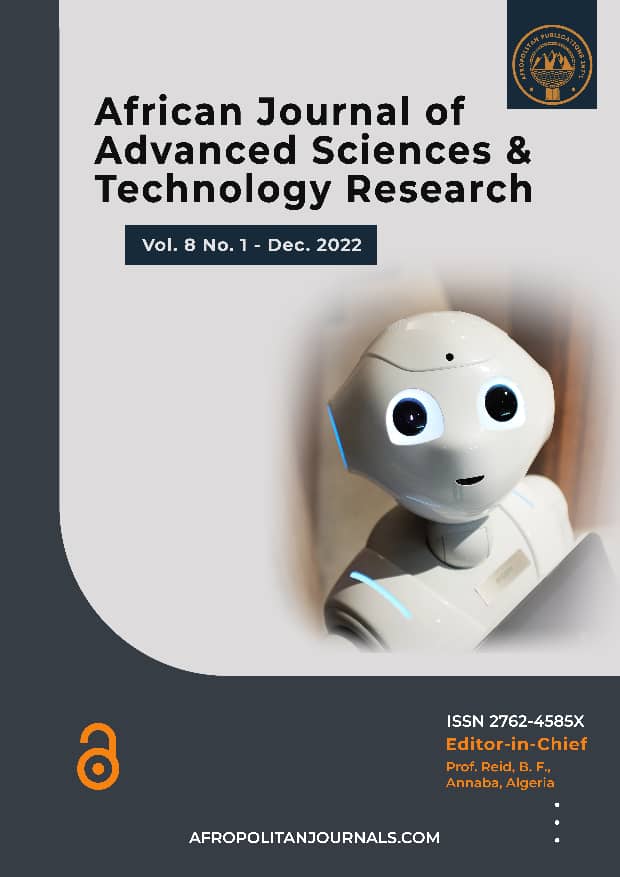The Prevalence of Bacterial Isolates in Borehole Water in Selected Communities of Emohua Local Government Area of Rivers State, Nigeria
Main Article Content
Abstract
Access to an improved source provides a measure of sanitary protection but does not ensure water is free of fecal contamination nor is it consistent between sources types or settings. International estimates therefore greatly overstate the use of safe drinking water and do not fully reflect disparities in access. An enhanced monitoring strategy would combine indicators of sanitary protection with measures of water quality. This investigated the prevalence of bacterial isolates on borehole waters in selected communities of Emohua local government area of River State, Nigeria. Bacterial isolates were identified based on cultural morphological characteristics and biochemical tests. The total heterotrophic bacteria count for the samples ranged from 1.0-6.0 x 10cfu/ml were low compared to the EPA and World Health Organisation standard of 1.0 x 102 cfu/ml for total heterotrophic bacteria count. Total coliform bacteria present in the samples had ranges from 0-180 MPN Index/100mL. The study, therefore, recommends that awareness should be enacted in order to educate the general public on the potential health implication associated with the consumption of poor water quality and proper treatment plan of the borehole water from these selected communities should be conducted regularly to prevent public health hazards.
Downloads
Article Details
References
Amiduo, S., Makonto, T.N., Pascal, O.E., Besong, P.O. Odiyo, J., Majapello, P. (2011). Microbial quantity diversity and antibiotic susceptibility profile of bacterial isolates from borehole water used by schools in Greater Giyani municipality, Mopani District, South Africa, Department of Biology: Academic Journal.org Article 1(2), 198 – 210.
Aminuchika, Amina, Y. Abubakar Amali, M., Mohamed A.B. (2019). Influence of administration of Metformin and Methanolic stem extract of Aniospus Mannil N.E. Br in Glucose homeostasis and lipid profile in streptozotocin/ncotinamide – Induced diabetic rats.
Atiku Sodiya (2018). Comparative study of the physic chemical and bacteriological qualities of some drinking water sources in Abuja. Nigeria; Global Journal of Pure and Applied Sciences Vol. 24 (1).
Bagh, L.K. et al (2004). Distribution of bacteria in a domestic hot water system in a Danish apartment building, Water Research 38(1) 225 – 235.
Benka-Coker, M.O. and Ohimain, E.I. (1995). Investigation of Spatial Variations in bacteria distribution in surface water in Ikpoba river, Nigeria. Journal of microbiology 10 (1995) 27 – 32.
Cheesebrough, M. (2006). District Laboratory practices in tropical countries 2nd Edition, Cambridge University Press, New York.
Cheesebrough, M. (2013). District laboratory practice in tropical countries, Cambridge University Press.
Edema, M.O., Omemu, A.M. and Fapetu, O.M. (2001). Microbiological and Physicochemical analysis of different sources of drinking water in Abeokuta, Nigeria. Niger Journal, Microbial, 15(1), 57 – 61.
Foka, F., Clarence S., Marie E. (2018). Physicochemical properties and microbiological quality of borehole water in four crowded area of Benin City, Nigeria, During Rainfall. Shiraz E-Medical Journal 1(2) 21-30.
Ibe, S.N. and Okpenye, J.I. (2005). Bacterial analysis of borehole water in Uli, Nigeria. http//doi:10,4514ajazchV7il.4118.0
Idibie, O.C. et al (2018). Comparative microbial analysis of Borehole water and other sources of water in Benin metropolis, Edo State, Journal of Environmental Science and Public Health 2(232 – 242).
Kiman-Murage, E.W. and Ngindu, A.M. (2007). Quality of water the slum dwellers use, this case of a Kenya slum: Journal of urban Health (220 – 222).
NAFDAC (2004). Food and Drug Act Cap. F. 32 LFN 2004.
Obioma, A., Chikanka, A.T. and Loveth N.W. (2017). Evaluation of Bacteriological quantity of surface well, borehole and river water in Khana Local Government Area, Rivers State, Niger Delta, Ann clin. Lab res. 5(3) 18 – 33/
Onuorah, S., Igwemadu, N. and Odibo, F. (2019). Bacteriological quality Assessment of Borehole water in Ogbaru Communities, Anambra State, Nigeria, Universal Journal of Clinical Medicine , 7 (1), 1-10.
Rogbesan, A.A., Eniola K-ii and Olayemu, A.B. (2002). Bacteriological Examination of some Boreholes within Ilorin Nigeria. Journal of Pure and Applied Science. 17: (1223 – 1226).
Ugbaja, V. C. & Otokunefor, T. V. (2015). Bacteriological and Physicochemical Analysis of Groundwater in Selected Communities in Obio Akpor, Rivers State, Nigeria. British Microbiology Research Journal 7 (5): 235-242.
Woke, G.N. and Bolaji, B.B. (2015). Assessment of groundwater quality in Emohua LGA, Rivers State, Nigeria. Journal of Natural Sciences Research, 1(2,) 24 – 30.
World Health Organization (2003). Meeting the MDG drinking water and sanitation Amid term Assessment of Progress, Geneva WHO/Unicef ISBN 9241562781.
World Health Organization (2011). Guidelines of drinking water quality, 4th edition. Acceptability aspect; taste, odour and appearance Geneva pp. 1 – 294.

